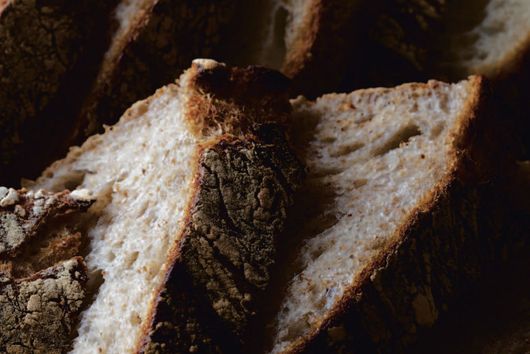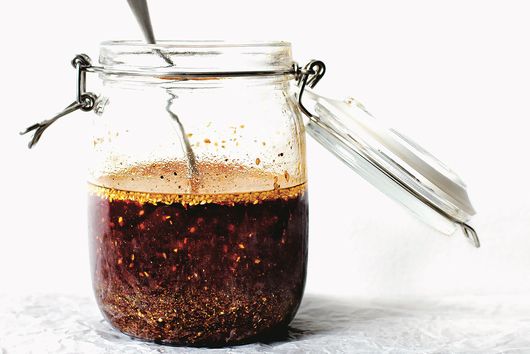Ken Forkish's Overnight 40% Whole Wheat Bread
★★★★★
PREP TIME
17 hours 20 minutes
COOK TIME
55 minutes
MAKES
2 loaves, each about 1 1/2 pounds, and is suitable for focaccia
Ingredients
4 2/3 cups
(600 grams) white flour (60% baker's percentage)
3 cups
plus 2 tablespoons (400 grams) whole wheat flour (40% baker's percentage)
3 1/2 cups
(800 grams) 90°F to 95°F (32°C to 35°C) water (80% baker's percentage)
1 tablespoon
plus 1 teaspoon (22 grams) fine sea salt (2.2% baker's percentage)
3/4 teaspoon
(3 grams) instant dry yeast (0.3% baker's percentage)
Instructions
- Autolyse Mix the 600 grams of white flour and the 400 grams of whole wheat flour by hand in a 12-quart round tub or similar container. Add the 800 grams of 90°F to 95°F (32°C to 35°C) water and mix by hand just until incorporated. Cover and let rest for 20 to 30 minutes.
- Mix Sprinkle the 22 grams of salt and the 3 grams (¾ teaspoon) of yeast evenly over the top of the dough. Mix by hand, wetting your working hand before mixing so the dough doesn’t stick to you. (It’s fine to rewet your hand three or four times while you mix.) Reach underneath the dough and grab about one-quarter of it. Gently stretch this section of dough and fold it over the top to the other side of the dough. Repeat three more times with the remaining dough, until the salt and yeast are fully enclosed. Use the pincer method to fully integrate the ingredients. Using your thumb and forefinger, make five or six pincer cuts across the entire mass of dough. Then fold the dough over itself a few times. Repeat, alternately cutting and folding until all of the ingredients are fully integrated and the dough has some tension in it. Let the dough rest for a few minutes, then fold for another 30 seconds or until the dough tightens up. The target dough temperature at the end of the mix is 77°F to 78°F (25°C to 26°C). Cover the tub and let the dough rise.
- Fold This dough needs three or four folds (see pages 69–70 for instructions). I recommend doing all of the folds in the first 2 hours after mixing the dough. When the dough is triple its original volume, about 5 hours after mixing, it’s ready to be divided.
- Divide Moderately flour a work surface about 2 feet wide. Flour your hands and sprinkle a bit of flour around the edges of the tub. Tip the tub slightly and gently work your floured free hand beneath the dough to loosen it from the bottom of the tub. Gently ease the dough out onto the work surface without pulling or tearing it. With floured hands, pick up the dough and ease it back down onto the work surface in a somewhat even shape. Dust the area in the middle, where you’ll cut the dough, with a bit of flour. Cut the dough into 2 equal-size pieces with a dough knife or plastic dough scraper.
- Shape Dust 2 proofing baskets with flour. Shape each piece of dough into a medium-tight ball. Place each seam side down in its proofing basket.
- Proof Place each basket in a nonperforated plastic bag and refrigerate overnight. The next morning, 12 to 14 hours after the loaves went into the refrigerator, they should be expanded but not overflowing their proofing baskets. There should be about a 2-hour window when the cold loaves, still in the refrigerator, are optimally proofed. They can go straight from the refrigerator into the oven. There is no need for or benefit in allowing them to come to room temperature first.
- Preheat At least 45 minutes prior to baking, put a rack in the middle of the oven and put 2 Dutch ovens on the rack with their lids on. Preheat the oven to 475°F (245°C). The bread can go into the oven right out of the refrigerator. There is no need for it to warm up first. If you only have 1 Dutch oven, put the second loaf into the refrigerator about 20 minutes before baking the first loaf and bake the loaves sequentially, giving the Dutch oven a 5-minute reheat after removing the first loaf.
- Bake For the next step, please be careful not to let your hands, fingers, or forearms touch the extremely hot Dutch oven. Invert the proofed loaf onto a lightly floured countertop, keeping in mind that the top of the loaf will be the side that was facing down while it was rising—the seam side. Use oven mitts to remove the preheated Dutch oven from the oven. Remove the lid. Carefully place the loaf in the hot Dutch oven seam side up. Use mitts to replace the lid, then put the Dutch oven in the oven. Maintain the temperature at 475°F (245°C). Bake for 30 minutes, then carefully remove the lid and bake for 20 to 25 minutes, until at least medium dark brown all around the loaf. Check after 15 minutes of baking uncovered in case your oven runs hot. Remove the Dutch oven and carefully tilt it to turn the loaf out. Let cool on a rack or set the loaf on its side so air can circulate around it. Let the loaf rest for at least 20 minutes before slicing.





